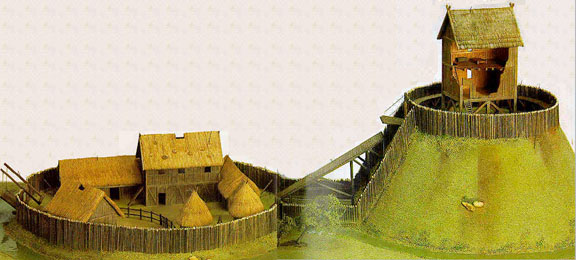

Castles were primarily built during the wars of the late Middle Ages for the purpose of protection. Originally, the castle was simply built, but the need for better protection rose and they became much more sophisticated. The castle started as a simple wooden structure on top of a mound surrounded by a ditch. If the land was flat, an artificial moat would be constructed. Later, a series of raised walls were created to separate the moat from the actual castle. The space between the moat and castle became known as the bailey. By the eleventh century, this form of castle was most popular. As time passed, the walls were made thicker and were topped with battle parapets. When the Normans came, the masonry keep, or dungeon, was added within the confines of the bailey. This keep, which was most often 40 to 50 ft. high, had thick walls and very small windows. Wide deep moats replaced the crude ditches which were supposed to be filled with water. These, however, were usually dry. Moats were crossed by drawbridges that could be raised from within the castle. At the castle's end of the drawbridge was an opening in the wall that contained a portcullis, which was a thick, iron-plated wooden door that could be raised to clear the entrance. If necessary, there were private apartments, a well for water, and everything else necessary to supply the people of the castle through a long siege. At first, the keep (dungeon) was rectangular, but later it was found that a round keep was easier to defend. In the 13th century, castles became even more sophisticated. Living quarters were moved into new buildings which were constructed within the bailey. The keep was then made smaller and stronger, becoming the final defensive position within a series of buildings. Castles were constructed on the edges of cliffs or ideally at a bend in the river where the surrounding area could be viewed well. At the end of the fifteenth century, gunpowder was used in projectiles. Castles were no longer necessary. The castle became just a residence and was unnecessary for protection.
To see a Medieval Castle click here
A Quotation which describes the Green Knight's Castle:
"Then he pricks his proud steed with the plated spurs, And by chance he has chosen the chief path That brought the bold knight to the bridge's end in haste.The bridge hung high in air;
The gates were bolted fast;
The walls well-framed to bear the fury of the blast.
The man on his mount remained on the bank
Of the deep double moat that defended the place.
The wall went in the water wondrous deep,
And a long way aloft it loomed overhead.
It was built of stone blocks to the battlements' height,
With corbels under cornices in comeliest style;
Watch-towers trusty protected the gate,
With many a lean loophole, to look from within:
A better-made barbican the knight beheld never.
And behind it there hoved a great hall and fair:
Turrets rising in tiers, with tines at their tops,
Spires set beside them, splendidly long,
With finials well-fashioned, as filigree fine.
Chalk-white chimneys over chambers high
Gleamed in gay array upon gables and roofs;
The pinnacles in panoply, pointing in air,
So vied there for his view that verily it seemed
A castle cut of paper for a king's feast."
Lines 777-802.